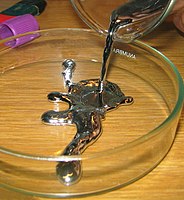
Photo from wikipedia
Abstract Thiols are the compounds that contain –SH functional group in their molecular structures. They are also called as sulfanyls, sulfhydryls or mercaptans. Generally, thiol based compounds behave as strong… Click to show full abstract
Abstract Thiols are the compounds that contain –SH functional group in their molecular structures. They are also called as sulfanyls, sulfhydryls or mercaptans. Generally, thiol based compounds behave as strong ligands for binding with the metallic surface. Their binding ability with the metallic surface can be further improved by introducing the aromatic ring(s), polar substituents and hydrocarbon chains. Literature survey shows that compounds containing thiol functional group are widely used as corrosion inhibitors. Obviously, during metal-inhibitor interaction, –SH functional group interacts and adsorbs on the metallic surface whereas remaining part of the molecule acts as water repellent. Most of the thiol compounds become effective by adsorbing on the metallic surface that mostly follows the Langmuir absorption isotherm model. Most of the thiol compounds act as mixed-type inhibitors and their presence affect the anodic as well as cathodic reactions. Present review article describes the collection on some major and recent progresses on thiols as corrosion inhibitors.
Journal Title: Journal of Molecular Liquids
Year Published: 2021
Link to full text (if available)
Share on Social Media: Sign Up to like & get
recommendations!